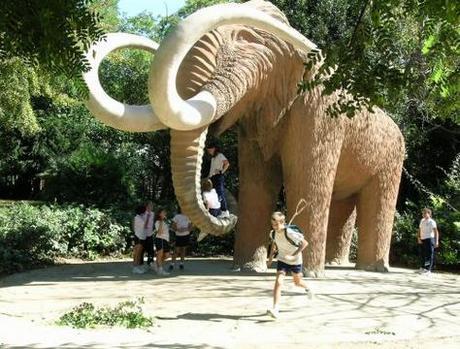Mammoth Museum
Mammoth Museum is in the gothic area of Barcelona. If you’re looking for a museum surrounding history that’s akin to say Cosmo Caixa with all its interactive pieces, this one is not to be missed.
It’s a step above a lot of other history museums in Barcelona. Foremost, the guides shape a tour in your language. You turn up, they do it. Next, the guides are palaeontologists, not hired lingual help that don’t know much more than the employee handbook.
If you've seen Barcelona's stone mammoth in Parc de Ciutadella and been inspired, how about a close encounter with the real thing at this bizarre but brilliant tribute to one of the world's largest creatures? The Barcelona Mammoth Museum features some unbelievable treasures, including one of the best-preserved proboscidean skeletons on the planet (it's huge!) as well as a 5-metre-high life-sized reconstruction of a mammoth using yak hair, which helps you visualise these giant beasts roaming the earth during the Ice Age. Best of all visitors are encouraged to touch and hold virtually all of the museum's displays, which include fossilised teeth of these ancient elephants, and the horn (which, as you will learn, is made of hair) of the woolly rhinoceros. The friendly staff will happily tell you more about all the exhibits, from the cave bear skeletons to the millenia-old tusks and dried skin of the mammoths themselves. You can buy tickets in advance via Atrapalo, or turn up any day before 9pm (the Museum is centrally located in El Born).
People have always wanted to understand more about the diverse nature of life on Earth and the mysterious manner in which animal species have appeared or disappeared in the course of history. Housing a varied collection of prehistoric animal skeletons and other remains as well as life-size animal reproductions, the Barcelona Mammoth Museum is designed to offer both the general public and specialist researchers a window on the nature of the Ice Age and Ice Age animals. The exhibits were brought together with the help of some of the world’s most complete paleontological collections and with prehistoric remains excavated during expeditions in the Americas, Canada and Russia.
On a visit to the Museum, visitors will be able to actually touch and feel the teeth and tusks of a mammoth, smell the horn of a woolly rhinoceros and see the faithful reproductions of primitive cave paintings that decorate the walls and ceilings. One of the rooms also showcases mammoth ivory carvings made by the most accomplished artisans from all over the world.
Finally, the Barcelona Mammoth Museum also offers a variety of extra services, including specialist technical services for the scale reconstruction of Ice Age animals, a children’s club for budding paleontologists and an interactive guided tour designed for school visits.
In one ancient legend a mammoth is called “a big bull”. He struggled with dragons which invaded the Earth devouring every leaving creature. When the battle was over and the big bull was left alone, being wounded, he made a large leap, skipped over the Pyrenees and escaped in the far-off lands. So it can be interpreted that mammoths migrated to the north.
When people in the ancient world dug out gigantic bones they presumed that these were remains of the Trojan War heroes. Later on in the Middle Ages and up to the 19th century mammoth bones were taken for remains of giants from the Bible who died in the Flood.
A fragment of a mammoth thighbone found in the Pyrenees and kept in St George’s Abbey is considered to be the bone of St Geordie, father of Guifre el Pilos, who killed the dragon at the Mon Blanc gates. Guifre el Pilos was born in the Pyrenees, and it was he who unified Catalonia lands under one flag. There was a good reason why he got his nickname Pilos. As folk epos says, “all his body was covered with thick hair. There was hair even on his heels. And he was as big as a mammoth.” In Valencia, a mammoth tooth was worshiped as a piece of St Christopher’s hallows, and in 1789 St Vincent’s canons wore mammoth thighbones at religious processions and passed it off as a part of the saint’s arm.
In villages at the bottom of the Pyrenees there are holidays when the locals seat against each other, put on costumes and arrange parades where they imitate their big ancestors. From high antiquity times on people have been interested in their origin. Attempts to understand and explain how a man appeared can be found in many religions, legends and myths of different peoples. Mankind has been restlessly trying to find traces of the millenary as well as the millioned past. Character features and mentality of a particular group of people have much in common with some image of an animal.
You can get there via direct flight to Barcelona or to Girona, Reus or Lleida–Alguaire.




